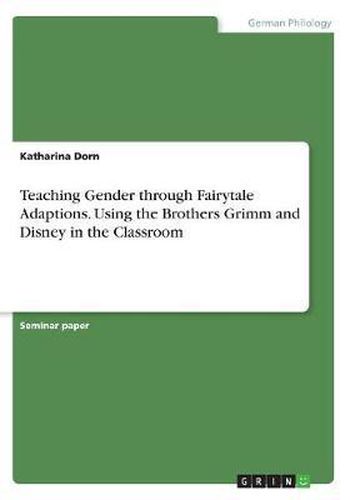Readings Newsletter
Become a Readings Member to make your shopping experience even easier.
Sign in or sign up for free!
You’re not far away from qualifying for FREE standard shipping within Australia
You’ve qualified for FREE standard shipping within Australia
The cart is loading…






Seminar paper from the year 2017 in the subject German Studies - Comparative Literature, grade: 2,2, Justus-Liebig-University Giessen, language: English, abstract: Are princesses still living happily ever after or did they change? This paper seeks out to answer this question by a taking a look at fairy tales and their Disney movie adaptions. It will be argued that a comparison of Disney films and traditional fairytales offers a great possibility to teach gender. The goal of this paper is, therefore, to enhance the understanding of older and newer storytelling concerning gender and its benefits for teaching English as a foreign language. Listening to marvelous tales and stories is and has always been omnipresent in children’s life. Everyone knows the Brothers Grimm and Disney who are popular for their fantastic stories. These stories have been patterns for many Disney movies that have become omnipresent and essential in todays media. Especially Disney is very popular among young students. It is obvious that children are likely to identify with these stories. Consequently, it is important to analyze views and values that are presented in these newer films in comparison to older and more traditional Grimm fairytales. The first part of this paper offers a description of gender roles and depictions in Grimm and Disney in order to promote the understanding of the two genres. Moreover, there will be a focus on the development of Disney’s gender depiction because of the obvious change in their portrayal of female characters. In the second part, then, these theoretical ideas and background information are applied to two concrete stories by Grimm and Disney. Firstly, the fairytale Der Froschkonig oder der eiserne Heinrich will be analyzed concerning its depiction of gender. Secondly, Disney’s adapted film The Princess and the Frog will also be analyzed according to its depiction of gender and the change that has been made since Grimm’s story. The third part deals with
$9.00 standard shipping within Australia
FREE standard shipping within Australia for orders over $100.00
Express & International shipping calculated at checkout
Seminar paper from the year 2017 in the subject German Studies - Comparative Literature, grade: 2,2, Justus-Liebig-University Giessen, language: English, abstract: Are princesses still living happily ever after or did they change? This paper seeks out to answer this question by a taking a look at fairy tales and their Disney movie adaptions. It will be argued that a comparison of Disney films and traditional fairytales offers a great possibility to teach gender. The goal of this paper is, therefore, to enhance the understanding of older and newer storytelling concerning gender and its benefits for teaching English as a foreign language. Listening to marvelous tales and stories is and has always been omnipresent in children’s life. Everyone knows the Brothers Grimm and Disney who are popular for their fantastic stories. These stories have been patterns for many Disney movies that have become omnipresent and essential in todays media. Especially Disney is very popular among young students. It is obvious that children are likely to identify with these stories. Consequently, it is important to analyze views and values that are presented in these newer films in comparison to older and more traditional Grimm fairytales. The first part of this paper offers a description of gender roles and depictions in Grimm and Disney in order to promote the understanding of the two genres. Moreover, there will be a focus on the development of Disney’s gender depiction because of the obvious change in their portrayal of female characters. In the second part, then, these theoretical ideas and background information are applied to two concrete stories by Grimm and Disney. Firstly, the fairytale Der Froschkonig oder der eiserne Heinrich will be analyzed concerning its depiction of gender. Secondly, Disney’s adapted film The Princess and the Frog will also be analyzed according to its depiction of gender and the change that has been made since Grimm’s story. The third part deals with